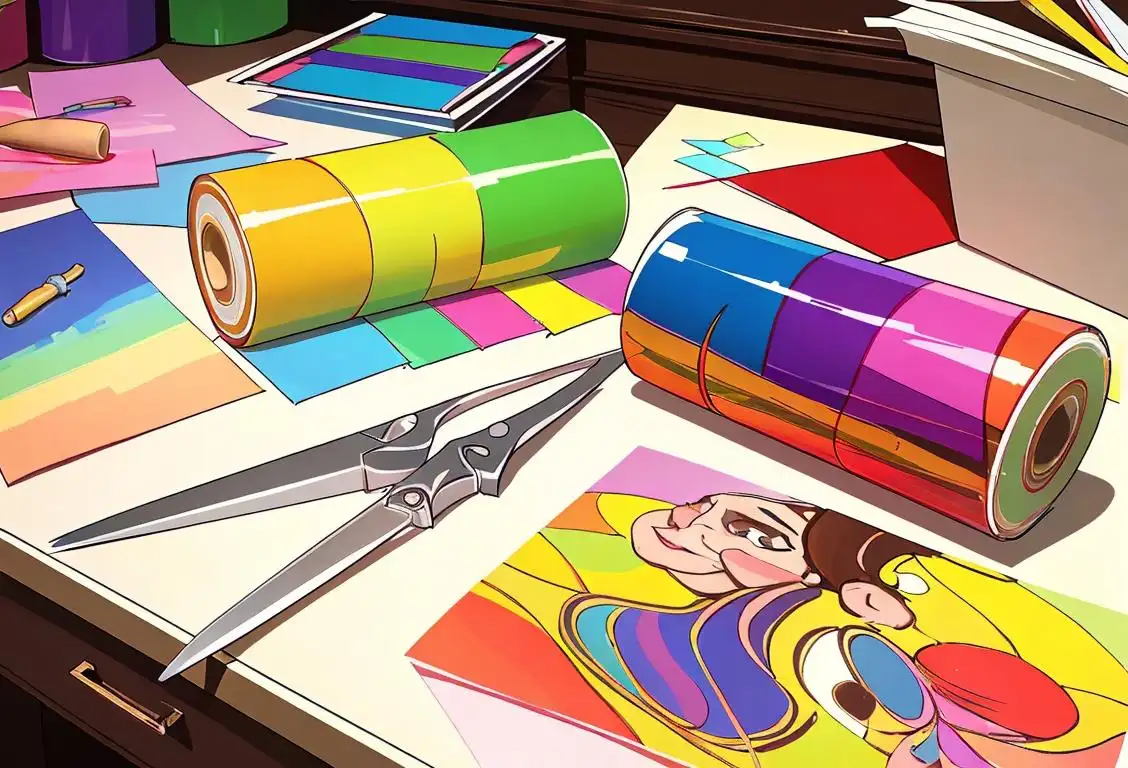National Cellophane Tape Day

Get ready to stick around and learn all about National Cellophane Tape Day!
When is Cellophane Tape Day?
It's national cellophane tape day on the 27th May.
The Sticky History of Cellophane Tape
Imagine a world without cellophane tape. It would be a sticky situation indeed! Fortunately, we have National Cellophane Tape Day to celebrate this ingenious invention that holds our lives together, quite literally!
Cellophane tape, also known simply as 'tape' or 'sticky tape,' is a versatile adhesive wonder. It's made by coating a thin strip of plastic film, typically made of cellulose, with adhesive on one side. The adhesive is usually made from a type of rubber or acrylic that provides an excellent grip.
Now, let's dive into the internet history of this highly adhesive holiday.
National Cellophane Tape Day first gained attention on May 27, 2018, when it received a whopping 88 mentions online. It seems like people couldn't stop talking about this sticky celebration, and for a good reason! Since then, every year on May 27, people come together to honor the adhesive power of cellophane tape.
Fun Traditions and Activities
Celebrating National Cellophane Tape Day is as easy as peeling off a strip of tape. Here are some fun traditions and activities you can join in on:
- Create unique crafts using cellophane tape, like making origami animals or decorating cards.
- Challenge your friends to a cellophane tape sculpture contest. Who can build the tallest tower using only tape?
- Host a tape-themed movie night. Pick films featuring characters who use tape in clever ways (think MacGyver or The Fantastic Four).
Did You Know?
Here's a fun fact to impress your friends: Cellophane tape wasn't always so easy to handle. In the early days, tape rolls were a nightmare to find the end of! It could take minutes (or even hours) of frustratingly futile attempts. Thankfully, in 1935, Richard Drew, an engineer at 3M, introduced the world to the first transparent cellophane tape with a built-in easy-to-find end. Talk about a sticky genius!
History behind the term 'Cellophane Tape'
1925
Invention of transparent tape
In 1925, a young engineer by the name of Richard Gurley Drew invented an adhesive tape that was transparent and coated with a sticky substance. This tape became the precursor to what we now know as cellophane tape. At the time of its invention, it was primarily used for industrial purposes.
1928
The Birth of Cellophane
In 1928, a Swiss chemist named Jacques E. Brandenberger invented cellophane, a transparent film made from cellulose. Initially, cellophane was used as a moisture barrier for food packaging, replacing the commonly used materials like wax paper and cellophane paper. This innovation quickly gained popularity due to its transparency, flexibility, and resistance to moisture.
1930
The Invention of Tape Dispenser
Two years later, in 1930, a young engineer named Richard Drew, working for the Minnesota Mining and Manufacturing Company (3M), created the first practical adhesive tape. This tape, initially marketed as Scotch Cellulose Tape, featured a pressure-sensitive adhesive applied to cellophane. However, users faced the inconvenience of tearing the tape by hand, often leading to frustratingly uneven edges.
1930
Introduction of cellophane tape
Five years after the invention of transparent tape, the 3M company introduced a new version called 'Scotch Cellulose Tape,' which was made from a type of cellulose material known as cellophane. This cellophane tape was initially used for sealing packages and wrapping gifts, gradually gaining popularity among consumers.
1937
Renaming as cellophane tape
In 1937, 3M decided to rename their popular product to 'cellophane tape' to better reflect its material composition. Cellophane, derived from cellulose, became a widely recognized term as it referred to a transparent, thin film made from wood pulp. The term 'cellophane tape' gained traction and remains in use today.
1935
Introducing the Cellophane Tape Dispenser
In 1935, 3M responded to the consumer demand for a more convenient way to dispense cellophane tape by introducing the Cellophane Tape Dispenser. This cleverly designed handheld device included a built-in serrated metal edge that allowed users to tear off tape with ease, ensuring clean and straight edges. The product quickly gained popularity and made cellophane tape accessible and user-friendly.
1940
Evolution into Cellophane Tape
By the 1940s, the name 'Cellophane Tape' had become synonymous with adhesive tape made from cellophane. 3M continued to refine the product, further improving its adhesive quality and overall durability. Over time, cellophane tape found countless applications, from household use to industrial packaging and office supplies. It revolutionized various industries and became an indispensable tool in daily life.
Trademark Withdrawal
Trademark Withdrawal
Interestingly, in the 1960s, 3M decided to withdraw the 'Cellophane Tape' trademark, allowing other manufacturers to use the term. This decision resulted in the term 'cellophane tape' becoming a genericized trademark for any transparent adhesive tape, regardless of the materials used. Today, people commonly refer to any clear tape as cellophane tape, though it may not necessarily be made from cellophane.
Did you know?
Cellophane tape wasn't always so easy to handle. In the early days, tape rolls were a nightmare to find the end of! It could take minutes (or even hours) of frustratingly futile attempts. Thankfully, in 1935, Richard Drew, an engineer at 3M, introduced the world to the first transparent cellophane tape with a built-in easy-to-find end. Talk about a sticky genius!Tagged
fun technologyFirst identified
27th May 2015Most mentioned on
27th May 2018Total mentions
88Other days
Techies Day
Skyscraper Day
Manufacturing Day
It Professionals Day
Stockpile Website A Day
Battery Day
Video Games Day
Radio Day
Stem Day
Odometer Day









